Semi-electric stackers are critical equipment that increase efficiency in warehouse and logistics operations, providing ergonomic and cost-effective solutions. So, what exactly are these machines, and why should every warehouse have them?
What is a Semi-Electric Stacker?
A semi-electric stacker is a piece of storage equipment that an operator can maneuver using physical force (walking or pulling), but uses an electric motor to lift and lower them. As the name suggests, while they have less automation than fully electric stackers, they offer significantly greater lifting capacity and speed than manual pallet trucks. Typically powered by a battery system, these stackers are used to lift pallets to a specific height off the ground and place them on storage racks.
Why Choose a Semi-Electric Stacker?
- Cost-Effectiveness: They are more affordable than fully electric stackers. They are an ideal solution for small and medium-sized businesses with budget constraints. Both the purchase cost and maintenance and operating expenses are generally lower. Ergonomics and Occupational
- Safety: Manual stacking and handling operations can lead to serious musculoskeletal disorders for workers. Semi-electric stackers significantly reduce this risk by assisting the operator in lifting heavy loads.
- Increased Productivity: They offer much faster and more efficient load lifting compared to manual handling methods. An operator can move and place a large number of pallets in a short time with a semi-electric stacker.
- Flexibility and Maneuverability: Because they generally have a compact design, they can easily maneuver even in narrow aisles and small storage areas.
- Lower Energy Consumption: They consume less energy than fully electric forklifts. This feature lowers operating costs and reduces environmental impact. Furthermore, they can generally be charged from standard outlets, eliminating the need for additional charging infrastructure investments.
Areas of Use
- Warehouses and Logistics Centers: They are widely used in basic warehouse operations such as storing palletized goods, placing them on shelves, and preparing them for shipment. They are particularly ideal for warehouses with medium-volume load movements. Production
- Facilities: These systems are used for material handling on production lines and the storage of semi-finished and finished products. They save space in small and medium-sized production workshops.
- Retail Stores and Supermarkets: They facilitate product handling and placement from storage to shelf filling.
- Raw Material Warehouses: They offer an effective solution for storing and transporting various raw materials to production areas.
- Cold Storage: Some models are also suitable for use in cold storage, a significant advantage for the food and pharmaceutical industries.
Maintenance and Safety Tips
- Periodic Maintenance: Routine maintenance, such as battery checks, brake adjustments, wheel condition, and lifting mechanism lubrication, should be performed regularly. The manufacturer's maintenance schedule should be followed.
- Battery Maintenance: Regularly charging and discharging the battery prolongs its life. The battery water level should be checked regularly and topped up with distilled water when necessary.
- Operator Training: It is vital that personnel operating the machine receive adequate training and are familiar with safety procedures. Knowledge of load-lifting capacity, balance, and maneuvering rules is essential.
- Safety Rules: Overloading should be avoided, the machine should not be used on unstable surfaces, and the work area should always be kept tidy and unobstructed. Visibility should always be a priority.
Semi-electric stackers are an indispensable element of the modern warehousing and logistics world. Their cost-effectiveness, ergonomic advantages, increased productivity, and flexible use make them an ideal solution for many businesses. By considering your warehouse's needs, you can discover the value an investment in a semi-electric stacker can add to your business.
We wish you good health.
